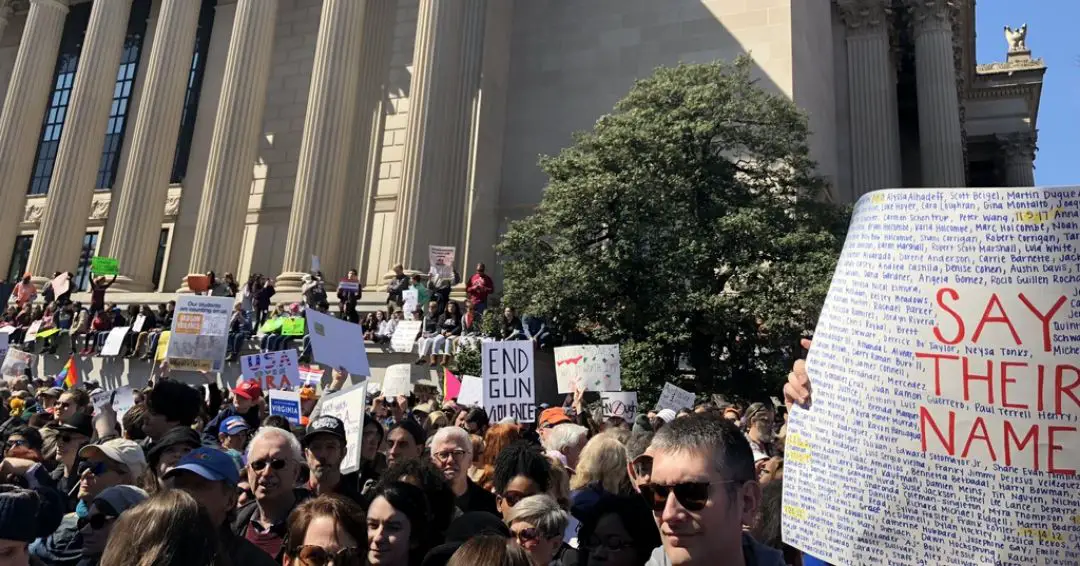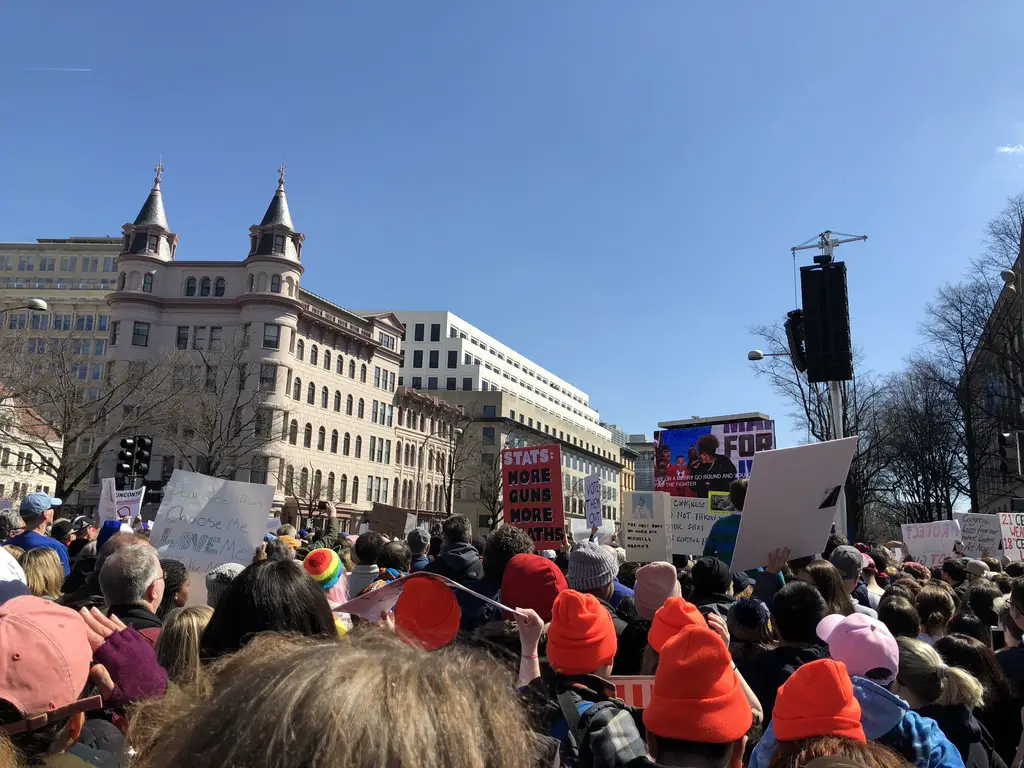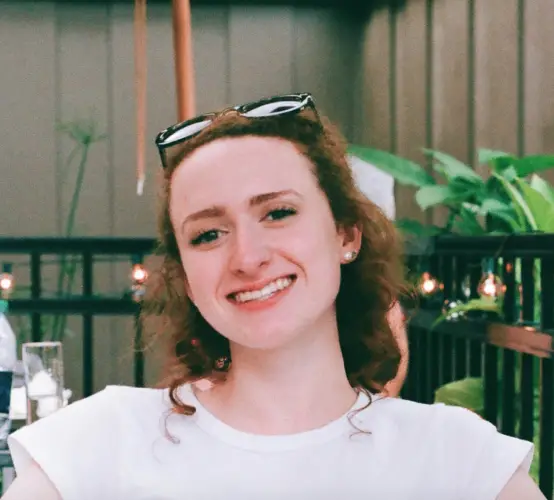On March 24, 2018, the victims of the Parkland shootings organized a March on Washington, D.C. An estimated 800,000 students and other protesters attended the March for Our Lives on Pennsylvania Avenue. As a result, the protest went down as the biggest gun reform protest in American history.
As the sun shone down on Washington on Saturday morning, the crowd grew progressively larger as the time drew nearer to noon. Before the march had even begun, chants of “Vote them out!” rang through the crowd, eventually making it down the many blocks that the protestors encompassed.
The chants referred to everyone’s displeasure with the actions of the current government. At 12:08 p.m. exactly, the screens scattered throughout the crowd began the countdown to the beginning of the march, and then it began.
The march featured student speakers who have suffered through various gun violence acts in the past, the majority of them from Parkland. On top of speakers, the march also featured musical performances from musicians such as Miley Cyrus and Demi Lovato.
But something was different about this march: every speaker was a student. Because students organized the March for Our Lives, it was fitting that the speakers were all under the age of 21, setting it apart from the past protests in Washington.
The crowd itself was made up of all ages, ranging from college students to grandparents to children. That’s what’s different about the gun reform issue: it affects everyone.
The future of America is in the hands of the younger generation, but gun violence is not a generational issue. Instead, all generations are connected.
As Deborah Betts, a protestor from Maryland, explains, “My daughter is a kindergarten teacher, and I left teaching myself 42 years ago because a student came after me with a gun and shot my car. This is enough. The time is up. You know what, it’s been up for a long time.”
That said, the issue does not just affect one section of America; the country has never seen such high amounts of gun violence and everyone is affected by it.
Looking into the crowd, one thing became clear: these protestors are not going to go away until the government solves the issue. Between each speaker and performance, the crowd would launch into an unprompted chant of “Vote them out!”
Contrary to the protestors’ relentlessness, Donald Trump has yet to make a statement mentioning the march or any new plans for gun reform. He has, however, tweeted about the border wall three times since the March for Our Lives, and he recently tweeted about how he could definitely beat Joe Biden in a fight.
At the march itself, individuals gathered from all across the country in order to protest for their rights. Sarah Lightbody, Harvard Class of 2022, remarked on the March for Our Lives.
She says, “I feel like we shouldn’t have to do this, but I’m so grateful to be surrounded by so many people who are getting out and are trying to create real change in this country since the legislators won’t.”

High school senior Margaret Parish, who also traveled all the way from Hanover, New Hampshire, says, “It’s scary to be a high schooler, but I’m proud to be one now that the kids from Parkland are turning something very scary into something very powerful.”
Parish points out the differences between this march and previous marches; March for Our Lives is a march for the kids because the adults of this country are no longer offering the necessary protection for the citizens of America.
The March for Our Lives lasted for about three hours. The mood shifted throughout the march, ranging from angry, to upset, to silent.
At times, looking to both the left and the right, students, friends and grandparents shed silent tears while listening to victims of gun violence share their stories. At the end of the day, few left the march with dry eyes.
But the mood would sometimes shift, and anger would sweep through the crowd to replace the grief. When videos of politicians, such as Donald Trump and Marco Rubio, were shown, the protestors would erupt in shouts and booing.
Though the March for Our Lives was an emotional journey that 800,000 people experienced together, the amount of anger in the crowd was different.
It was clear that while “thoughts and prayers” and mourning are important, they are no longer enough. Ultimately, anger and fear for our own children are going to fuel the continuation of this organization, leading to change.
Toward the end of the protest, Yolanda Renee King, Martin Luther King Jr’s 9-year-old granddaughter, joined the survivors of gun violence on stage. She spoke about how she, too, has a dream, and that enough is enough.
After Yolanda Renee King’s special appearance, Emma Gonzalez took the stage. As a senior at Parkland, Gonzalez has become one of the main faces of the movement.
Gonzalez’s speech was different. She spoke for a few minutes before falling into silence, staring into the camera as tears streamed down her face. The crowd reciprocated, as she stood on the stage for six minutes and 20 seconds, exactly how long it took the Parkland shooter to take 17 lives last February.
After the March for Our Lives, many protestors continued to walk to the White House, leaving signs and flags protesting the current gun laws on the gates surrounding the perimeter.
One thing was clear: this was just the beginning. As Cameron Kasky of Parkland said in his speech, “The March is not the climax. It is the beginning…If you think today is good, just wait for tomorrow.”
The emotions surging through the crowd on Saturday made it clear to everyone in Washington that a change was happening. Never before had a gun violence march gotten so much attention, and never before have there been so many protests.
The March for Our Lives was huge and made it clear that if a change doesn’t happen soon, the nation plans to vote the current politicians out.
Since the March for Our Lives, there have been arguments about how many people were truly there, or if it really did have a bigger turn out than Trump’s inauguration.
But there’s one thing that is clear to everyone, without any argument: The March for Our Lives made history, and this is just the beginning.
If you were unable to attend a march this weekend, there’s a list of ways to support the movement here. To donate to the march directly, go here.

















